Bike cleaning & washing: A How-to Guide
Cleaning your bike, oiling the chain etc.
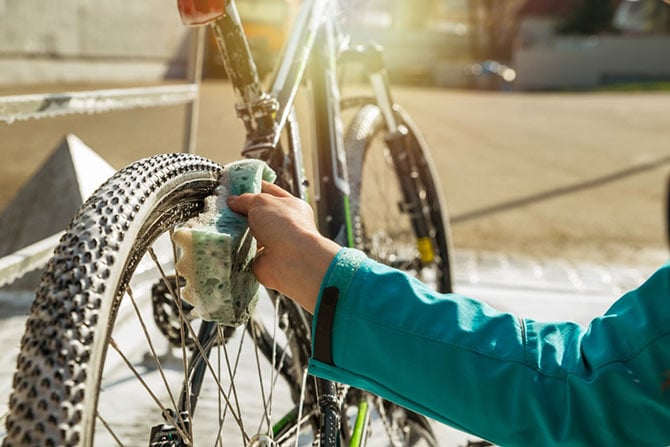
Those who love their bikes keep them clean. Too much dirt will shorten the life of your bike. Regular maintenance, however, can prevent avoidable wear and tear. In this article, we'll explain to you how to clean and oil your racing, mountain or road bike properly, how to correctly oilt he chain and whether expensive special cleaning agents are worth the hassle.
- Here's why regular bike care and maintenance is important
- Bike maintenance and cleaning: What you'll need for the task
- The right cleaner
- Should you wax or oil the bike chain?
- Should you clean using a high pressure washer or not?
- Checklist: What you'll need to care for your bike
- Step by step guide: How to clean your bike the right way
- Step 1: Soak the bike and get rid of mud
- Step 2: Clean the bike chain
- Step 3: Clean the disk brakes
- Step 4: Clean the gears and breaks
- Step 5: Maintenance
- Step 6: Oil the chain etc.
- Bike cleaning FAQs
Why regular bicycle care is important
It goes without any problems - so why should I clean or wash my bike? Quite simply: Dirt and the resulting rust, amongst other things, compromise the health of your entire bike. The cable's elasticity is reduced, the brakes get clogged with mud and the gears become too stiff to change. The service life of other parts is also shortened by dirt; the chain, for example, grinds off over time.
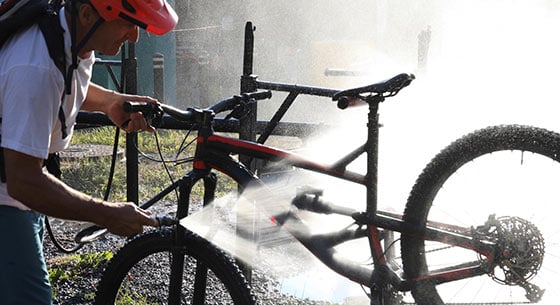
Especially in winter, regular cleaning is a must, because road salts attack not only the components of your bike but also the paintwork and promotes rust formation. But in general it is important to care for your bike as dirt can cause a component to break while riding and can lead to an injury!
Bike maintenance and cleaning: What you'll need for the task
There is a special cleaning agent for almost every part of the bicycle. They can be a bit expensive. For basic cleaning, you can do without expensive special cleaning agents. When caring for your chain, however, we recommend spending a bit more to ensure a long-lasting chain.
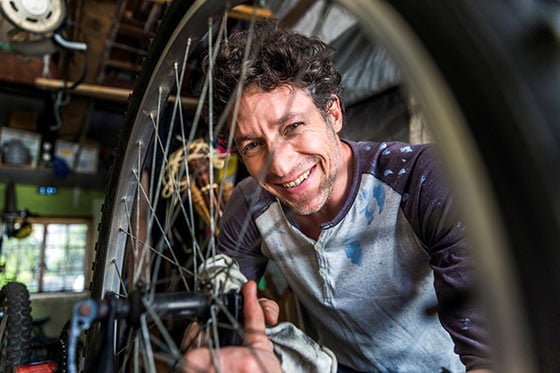
The right cleaner
Soap is perfect for cleaning the frame and wheels. Make sure that the soap is biodegradable if you are cleaning the bike outside.
For the cleaning of the chain, particularly if very dirty, you can use a penetrating lubricant, such as WD-40.
Important: Don't use strong or aggressive cleaning agents. Excess chemicals drip down onto the wheels, paint or other components, often causing damange to the bike.
Should you wax or oil the bike chain?
After an intensive cleaning of the chain, it is important that you also take care of it correctly. There are two options for this.
- Oil the chain:
You can choose between thin or thick oil. Dust and dirt adhere less to thin oil, but thin oil must be applied more often. Thick oil, on the other hand, attracts more dirt but is longer lasting. - Wax the chain:
Wax is dirt and water-repellent and therefore keeps the chain cleaner. In addition, it does not stain clothing. However, wax needs to be reapplied every 80 to 120 km, and therefore more often than oil (every 120 to 300 km).
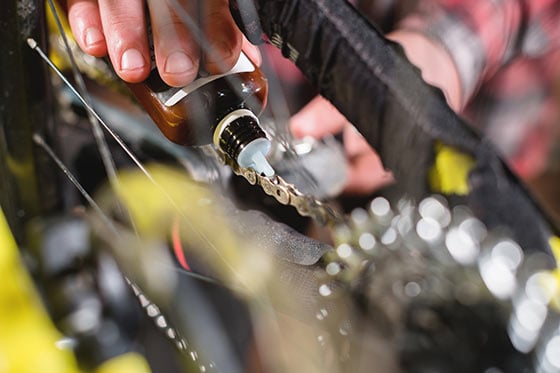
Should you clean using a high pressure washer or not?
Do not clean your bike with a high-pressure washer: High pressure can cause water to enter the sealed wheel bearings, which will then begin to rust. If you decide to still hose down your bike with a pressure washer, be careful not to get near the bearings.
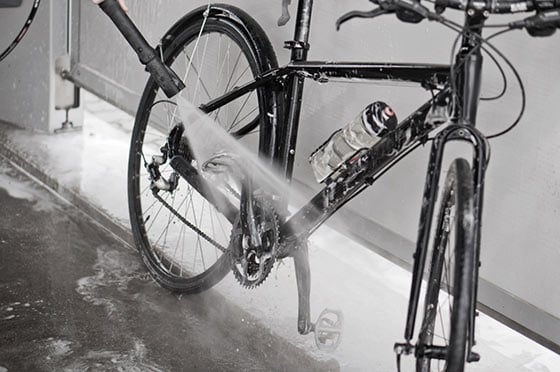
You can also use the following to clean your bicycle:
- A garden hose
- Several buckets of water
- A watering can
- A low-pressure washer with a water tank (e.g. the Mobile Outdoor Cleaner from Kärcher)
Checklist: What you'll need to care for your bike
Step-by-step guide: How to clean your bike properly
The most important up front:
- Coarse dirt should be removed from your bike after every ride. Follow step 1 to 3 for instructions on how to do so.
- In the following steps, we'll give you everything you need to know to clean and care for your bike.
Our Tip: Take the time while cleaning your bike to check for any damange.
Step-by-step guide: How to clean your bike properly
Before you start to remove dirt with a brush, you should first soak the bike.
» For step 1, you'll need:
- Water with soap
- Brush and sponge
- Toothbrush
- Spray oil (WD-40)
» Proceed as follows:
-
1. Soak the frame and wheels with rinse water for about 10 to 20 minutes.
2. Scrub off stubborn dirt with a brush or sponge.
3. Clean the wheels from inside to outside (hubs - spokes - rims).
4. Then move to the cassette, cleaning the chain rings and front derailleur with a sponge or toothbrush. For persistent dirt, use WD-40 or a degreaser.
5. Be sure not to pressure clean nuts, screws or bearings, shocks or the suspension fork, so that no water or dirt enters and rusts the ball bearings.
6. Finally, rinse the bicycle with a detergent on a low pressure setting.
Important: Rinse the brush or sponge often to avoid scratching the paint with microscopic rocks and dirt.
In the video you can see exactly how to clean the derailleur:
Step 2: Clean the bike chain
After cleaning your bike frame, the chain is up next. If you clean your bicycle chain, make sure that you do not completely degrease the chain. Otherwise, the oil between the pin and the chain links may become weak and break. Therefore avoide chain cleaning devices or similar.
» For step 2, you'll need:
- Rinsing water
- 2 cloths/rags
- WD-40
- Toothbrush(es)
» Here's how:
-
1. Dip a rag in water and grab the chain with it. Turn the crank so that the chain moves under your hand with the cloth.
2. For tough dirt, put a bit of WD-40 on another rag and run the chain through the rag in the same way.
3. Use a toothbrush to remove dirt between chain links.
Still not clear? The following video should give you an idea of what we mean:
Step 3: Clean the disk brakes
Intensive bike cleaning includes looking after the disc brakes. It is very important that the brakes are completely free of dirt and dust. While you're here, try to remove any rust that has accumulated here.
» For step 3, you'll need:
- Fine sandpaper or steel wool
- Water for rinsing
- Brushes
- Cloths or rags
- Brake cleaner, if needed

» Here's how:
-
1. Disconnect the bicycle's brake. This will help you better clean. You can find out how this works in the assembly instructions of your bicycle.
2. Remove coarse dirt with rinse water and a brush.
3. Use steel wool to remove any rust, or for any bumps you can use fine sandpaper.
4. Clean the disc brake again of residues that result from the brake pads being grounded up, for this you can use brake cleaner if necessary.
5. Reassemble the brakes after they've dried.
Step 4: Clean the gears and brake
COmplete bike cleaning includes the gear and brake cables. Dirt and water can easily get into the outer shell of the inner cables if the brake cables are exposed. Therefore, regular cleaning is therefore very important.
» For the 4th step, you'll need the following:
- Wet rags/cloths
- Grease
» Here are the steps:
-
1. Disconnect the brakes.
2. Unhook the front and back brakes at the tyres.
3. Shift down to the smallest gear.
4. Release the inner cables in the clamping area.
5. Take the entire cable out of the holders and move the outer cover to the side.
6. Clean the inner cableswith a damp cloth.
7. Give the inner cables a light coating of grease (Caution: Not with Teflon-coating!)
8. Reattach the brake cables.
In the following video, you'll see how to remove and grease the brakes:
Step 5: Maintenance
After cleaning, be sure to let your bike dry and also let all other components dry as well. Once everything has dried, you can begin maintenance. Maintenace means protecting it from wind, rain and damage. An important aid for bike care is oil and grease.
The drier the bike and the individual parts, the better the oil will stick. You can also spray the frame with an anti-dirt oil, let it set for 5 minutes and then wipe it away after. The oil will help prevent dirt and dust from sticking to the frame.
Step 6: Oil the chain etc.
Finally, spray the gears, cables and brake joints with oil, and remove excess oil with a damp cloth so that dust and dirt cannot stick.
Also grease your bicycle chain with oil or wax.
» When applying oil to the chain, you'll need:
- Chain oil or chain wax
- A cloth/rag
Make sure to apply grease sparingly. You can either apply the oil directly onto the chain parts or by pulling the chain through a rag with oil on it.
Here you can learn how to oil your bike chain:
Important: Be sure that no oil comes in contact with the brakes. Should this happen, remove the oil with a brake cleaner immediately.
Bike cleaning FAQs
How often should I clean my bike?
Coarse dirt and dust should be removed after every ride. A thorough bike cleaning is necessary approximately every 300 kilometres/150 miles.
How often should I clean and oil my chain?
If you do more off-road cycling, you'll need to oil the chainyour bike more often. We recommend the following intervals to regularly clean your chain:
- For road bikes: Check, clean and grease the chain every 300 kilometres/150 miles.
- For mountain bikes: Check, clean and grease the chain every 120-150 kilometres/60-75 miles.
Tough dirt should be removed with a brush and water after every trip.
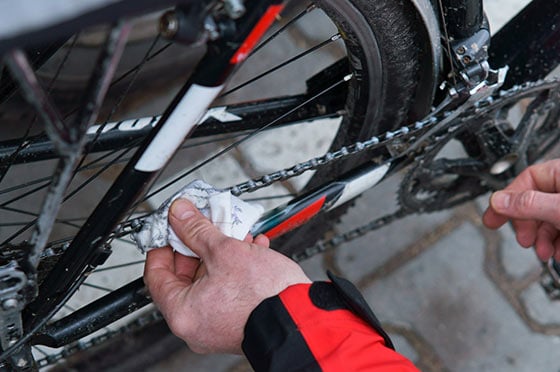
Where can I clean my bike?
When cleaning, be sure that
- only eco-friendly agents are used.
- the ground is dry and does not kick up any dirt. We recommend cleaning on concrete.
It is best to clean your bike on asphalt or concrete in your backyard or driveway. If greasing or oiling, you should do such on a piece of cardboard to protect the ground from harmful chemicals. If you have a bathtub that is big enough, you can also clean your bicycle there.
Our tip: With a mounting stand, you can fix your bike at eye level and get into hard to reach places
Ready for your next adventure!
Your bike is spick and span and ready for the next adventure? Make sure your bike fits you from head to toe. In our article „Getting the right bike for you“, you'll learn how to find the right bike for your size.
If you plan on biking through the Winter, we have some tips for winter biking.
So that the next bike tour doesn't fall flat, you can't go without a individualised personal jersey. In our 3D Designer you can creatively design high-quality jerseys - for mountain bikes and road bikes alike.
Image Credits: Title Image: Vera_Petrunina/iStock, Image 1: AscentXmedia/iStock, Image 2: ZimaNady_klgd/iStock, Image 3: Portra/iStock, Image 4: yanik88/iStock, Image 5: ZimaNady_klgd/iStock, Image 6: yanik88/iStock.